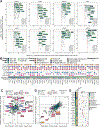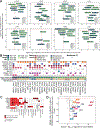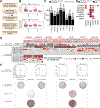Pan-cancer proteogenomics expands the landscape of therapeutic targets
- PMID: 38917788
- PMCID: PMC12010439
- DOI: 10.1016/j.cell.2024.05.039
Pan-cancer proteogenomics expands the landscape of therapeutic targets
Abstract
Fewer than 200 proteins are targeted by cancer drugs approved by the Food and Drug Administration (FDA). We integrate Clinical Proteomic Tumor Analysis Consortium (CPTAC) proteogenomics data from 1,043 patients across 10 cancer types with additional public datasets to identify potential therapeutic targets. Pan-cancer analysis of 2,863 druggable proteins reveals a wide abundance range and identifies biological factors that affect mRNA-protein correlation. Integration of proteomic data from tumors and genetic screen data from cell lines identifies protein overexpression- or hyperactivation-driven druggable dependencies, enabling accurate predictions of effective drug targets. Proteogenomic identification of synthetic lethality provides a strategy to target tumor suppressor gene loss. Combining proteogenomic analysis and MHC binding prediction prioritizes mutant KRAS peptides as promising public neoantigens. Computational identification of shared tumor-associated antigens followed by experimental confirmation nominates peptides as immunotherapy targets. These analyses, summarized at https://targets.linkedomics.org, form a comprehensive landscape of protein and peptide targets for companion diagnostics, drug repurposing, and therapy development.
Keywords: pan-cancer, proteogenomics, drug targets, proteomics, synthetic lethality, neoantigens, tumor antigens, data integration.
Copyright © 2024 The Authors. Published by Elsevier Inc. All rights reserved.
Conflict of interest statement
Declaration of interests V.H. owns stock of Marker Therapeutics and Allovir. B.Z. received a consulting fee from AstraZeneca.
Figures







Comment in
-
Proteogenomics identifies anticancer targets.Nat Rev Drug Discov. 2024 Sep;23(9):660. doi: 10.1038/d41573-024-00127-y. Nat Rev Drug Discov. 2024. PMID: 39054398 No abstract available.
References
-
- Bashraheel SS, Domling A, and Goda SK (2020). Update on targeted cancer therapies, single or in combination, and their fine tuning for precision medicine. Biomed. Pharmacother. 125, 110009. - PubMed
-
- Mani DR, Krug K, Zhang B, Satpathy S, Clauser KR, Ding L, Ellis M, Gillette MA, and Carr SA (2022). Cancer proteogenomics: current impact and future prospects. Nat. Rev. Cancer 22, 298–313. - PubMed
MeSH terms
Substances
Grants and funding
LinkOut - more resources
Full Text Sources
Medical
Research Materials
Miscellaneous

